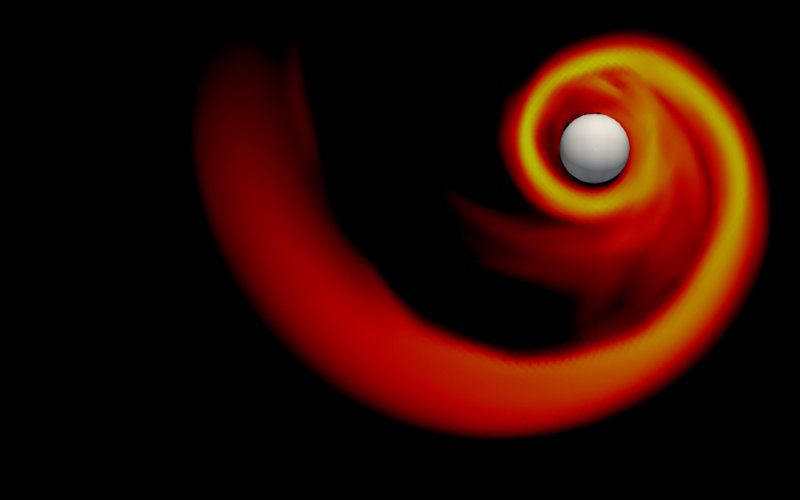
For the first time, gravitational-wave scientists have detected two collisions between a black hole and a neutron star, with Cal State Fullerton researchers involved in interpreting the novel cosmic events.
The extreme mergers made splashes in space that sent gravitational waves rippling across at least 900 million light-years to reach Earth. In each case, the neutron star was likely swallowed whole by its black hole partner.
Contributing to this discovery are Cal State Fullerton’s Jocelyn Read, associate professor of physics, postdoctoral research associate Philippe Landry and physics graduate student Derek White ’20 (B.S. physics), all of the Nicholas and Lee Begovich Center for Gravitational-Wave Physics and Astronomy (GWPAC).
The physicists are co-authors of the scientific journal paper published today in The Astrophysical Journal Letters and made contributions to the analysis of the data.
Jocelyn Read, associate professor of physics
“Observing this new category of gravitational-wave sources tells astronomers about the cosmic history of the massive stars that are needed to produce neutron stars or black holes,” said Read, an astrophysicist. “We have the first estimates of how often these collisions occur and how much events like this might contribute to the formation of heavy elements in our universe’s history.”
This latest discovery was announced by the National Science Foundation’s Laser Interferometer Gravitational-Wave Observatory (LIGO) in the United States and by the Virgo detector in Italy. The KAGRA detector in Japan, which joined the LIGO-Virgo network in 2020, was not online during these detections.
Scientists observed two black-hole-neutron star events occurring just 10 days apart in January 2020. The first merger, detected on Jan. 5 involved a black hole about nine times the mass of our sun, or nine solar masses, and a 1.9-solar-mass neutron star. The second merger was detected on Jan. 15, and involved a six-solar-mass black hole and a 1.5-solar-mass neutron star. Black holes and neutron stars are the corpses of massive stars, with neutron stars limited to at most a few times the mass of the sun, Read explained.
Philippe Landry, postdoctoral research associate
Landry has been a leader in developing the LIGO-Virgo-KAGRA collaboration’s methods for carefully assessing whether the lower-mass stars should be interpreted as neutron stars.
“Usually, we rely on light or tidal effects to identify neutron stars,” he said. “In this case, we only had the masses to go on,” Landry said. “The collaboration determined that practically all of the neutron star matter was eaten by the black hole in one bite, leaving no leftovers to power the light show that telescopes looked for — so, no fireworks this time.”
Previously, the LIGO-Virgo network found two other candidate neutron star-black hole mergers. One event called GW190814, detected Aug. 14, 2019, involved a collision of a 23-solar-mass black hole with an object of about 2.6 solar masses, which could be either the heaviest known neutron star or the lightest known black hole.
The first gravitational wave discovery from merging black holes was in 2015 and announced in 2016, which confirmed a major prediction of Albert Einstein’s 1915 general theory of relativity and led to the 2017 Nobel Prize in Physics. Since then, scientists, including CSUF researchers, have identified more than 50 gravitational-wave signals from the merging of pairs of black holes and of pairs of neutron stars.
“We’ve seen gravitational waves from two neutron stars crashing together before, but these observations have given us a new kind of neutron-star binary to explore. And this time, thanks to work by Dr. Landry and his collaborators, we’re confident there were neutron stars in these sources,” Read said.
About Cal State Fullerton: The largest university in the CSU and the only campus in Orange County, Cal State Fullerton offers 110 degree programs, and Division 1 athletics. Recognized as a national model for supporting student success, CSUF excels with innovative, high-impact educational practices, including faculty-student collaborative research, study abroad and competitive internships. Our vibrant and diverse campus is a primary driver of workforce and economic development in the region. CSUF is a top public university known for its success in supporting first-generation and underrepresented students, and preparing all students to become leaders in the global marketplace. Our It Takes a Titan campaign, a five-year $200 million comprehensive fundraising initiative, prioritizes investments in academic innovation, student empowerment, campus transformation and community enrichment. Visit fullerton.edu.
# # #
Photo Caption: This is a supercomputer simulation of a neutron star-black hole merger, created by CSUF Class of 2021 physics graduate Jennifer Sanchez, who this fall, starts the doctoral program at Northwestern University, and her faculty mentor Geoffrey Lovelace, associate professor of physics. Credit: Jennifer Sanchez, Geoffrey Lovelace and Simulating eXtreme Spacetimes (SXS) collaboration